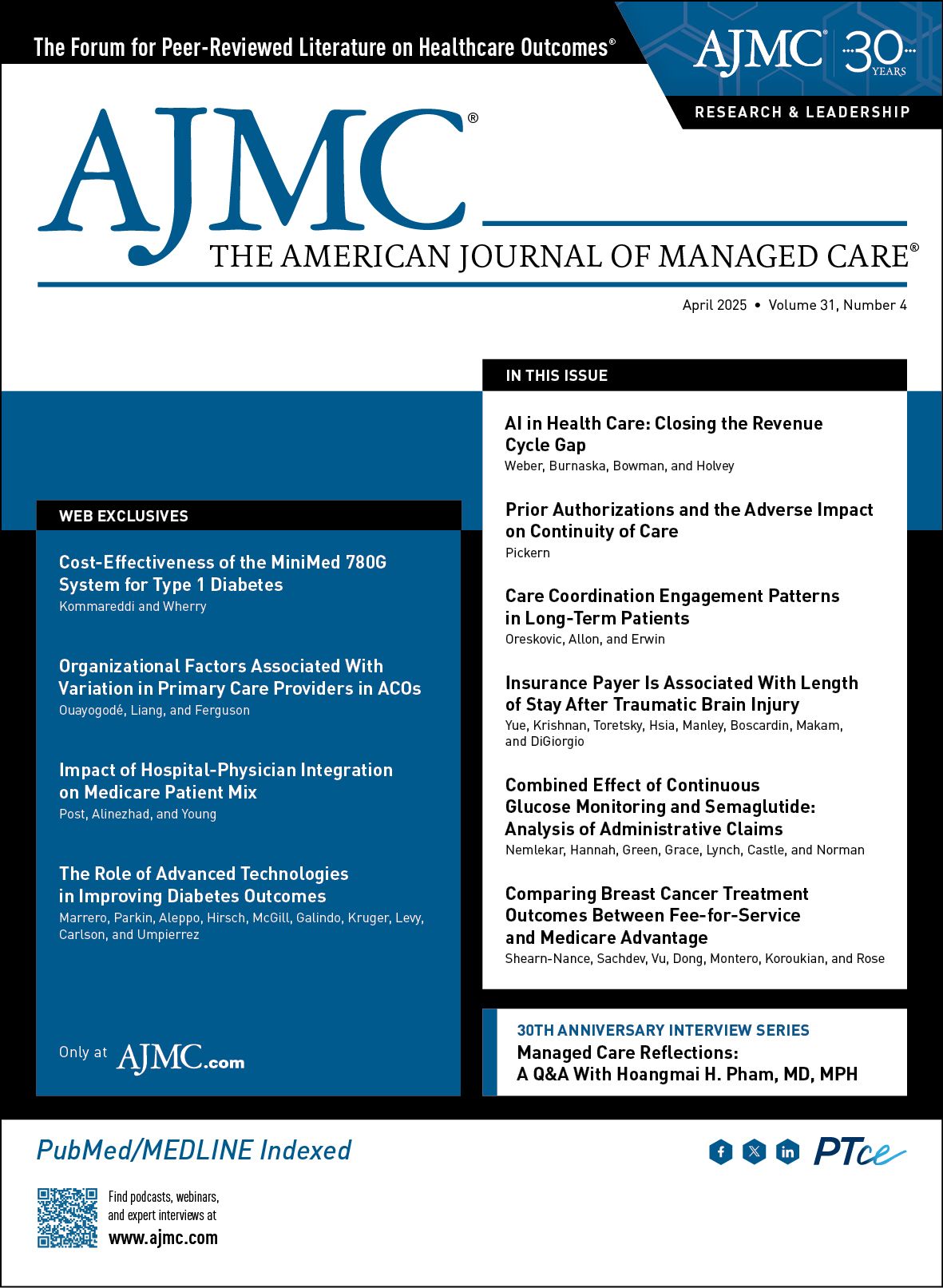Publication
Article
The American Journal of Managed Care
AI in Health Care: Closing the Revenue Cycle Gap
Author(s):
This commentary explores the current state, challenges, and potential of artificial intelligence (AI) in health care revenue cycle management, emphasizing collaboration, data standardization, and targeted implementation to enhance adoption.
Am J Manag Care. 2025;31(4):161-162. https://doi.org/10.37765/ajmc.2025.89717
Takeaway Points
This commentary highlights how adopting artificial intelligence (AI) in health care can streamline administrative processes, reduce costs, and improve efficiency. It provides practical insights for decision makers to implement AI in the revenue cycle effectively.
- AI can automate tasks such as claims processing, minimizing errors and administrative expenses.
- Collaborative use of AI between providers and health plans can enhance workflow efficiency.
- Ensuring high-quality, consistent data supports accurate AI applications.
- Policy makers can drive AI adoption by addressing privacy and cost concerns and promoting standardized practices.
Artificial intelligence (AI) is increasingly recognized as a transformative force in health care. By automating tasks and enhancing decision-making, AI has the potential to revolutionize both clinical and administrative processes. However, despite AI’s promise, the adoption of AI among health care providers remains limited. This article explores the current state of AI implementation, the potential benefits for the revenue cycle, and the opportunities for collaboration between providers and health plans to maximize AI’s impact.
The State of AI Adoption Among Health Care Providers
Recent research indicates that AI adoption in health care is still in its early stages. According to the 2023 CAQH Index Report,1 only 19% of medical providers and 12% of dental providers reported using AI for any activity. These results are consistent with the American Medical Association’s augmented intelligence research,2 showing that AI tools have yet to be widely used in health care delivery, even with the recent advancements in AI model design. This low adoption rate reflects broader industry trends, where AI tools, despite significant advancements, have yet to gain widespread traction.
The reluctance of providers to engage with AI can be attributed to several factors, including concerns about privacy,3 bias,4 and costs as well as a lack of vendor support for many common use cases. Furthermore, AI tools are more commonly used for administrative tasks than clinical ones, with activities such as verifying patient eligibility and generating visit notes being the most prevalent applications.1 These findings suggest that although the potential of AI is widely acknowledged, AI’s practical application in everyday health care remains limited.
Leveraging AI to Enhance the Revenue Cycle
One area where AI has shown significant promise is in enhancing the revenue cycle. Health plans have already begun using AI to support various administrative tasks, such as identifying and resolving errors in claims before submission and automating prior authorization processes. These early applications of AI in the revenue cycle have demonstrated the technology’s ability to streamline workflows and reduce administrative burdens.
To maximize the benefits of AI in the revenue cycle, collaboration between providers and health plans is essential. By working together, these stakeholders can ensure that AI tools are designed to meet the specific needs of the health care industry and are implemented in a way that supports both providers and payers. For instance, AI can be used to proactively identify services that require prior authorization, retrieve necessary documentation from electronic health records (EHRs), and submit it to health plans for adjudication. Health plans such as Florida Blue have already begun using AI for these types of revenue cycle purposes.5 Such collaborative efforts can help providers realize the full potential of AI in improving efficiency and reducing costs.
Targeting Specific Use Cases for AI Implementation
As the industry considers where this technology can bring the most benefit, using AI for administrative support—especially for the revenue cycle—is a clear area of consensus. Due to the ability of AI models to identify complex patterns and make highly accurate predictions, AI tools are emerging that can proactively identify and resolve errors within a claim that would likely lead to a denial, thus correcting the claim before it is submitted.6 Similarly, this approach can be used to prospectively identify services for a prior authorization that likely require an attachment.7 The attachment can be located in the EHR, retrieved, and submitted along with the prior authorization request to the health plan for consideration and adjudication.
Additionally, the CAQH CORE Eligibility and Benefits (270/271) Data Content Rule outlines several targeted categories of service, including physical therapy, occupational therapy, imaging, and surgery, where revenue cycle burdens can be most simply and quickly alleviated by tools that deploy AI models.8 By starting with these targeted solutions, the industry can validate the positive impacts of AI and learn valuable lessons that can be applied to broader implementations. This approach allows for a more controlled and effective rollout of AI technologies, ensuring that they deliver measurable benefits to both providers and patients.
Standardizing Data and Processes to Support AI
Another critical factor in maximizing the impact of AI is the standardization of data and processes. Operating rules, which govern many health care revenue cycle transactions, contribute to this effort by ensuring that the data fed into AI models are of higher quality and consistency.9 With standardized data elements and processes in place, AI models can be trained more effectively and be more accurate. Although operating rules themselves may not be directly incorporated into AI solutions, the improved quality and uniformity of data they enable are key to realizing AI’s full potential.
Standardization not only enhances the accuracy of AI models but also accelerates AI adoption across the industry.10 As more providers and health plans leverage high-quality, standardized data in their AI tools, the collective benefits will grow, driving greater efficiency and improving patient care.
Implications for Policy Makers and Researchers
The slow adoption of AI in health care, particularly among providers, raises important questions for policy makers and researchers. As AI continues to evolve and gain attention from stakeholders, it is crucial to understand the factors driving adoption and the barriers that need to be addressed. Research into the impact of AI on provider burden, particularly in relation to administrative tasks, will be essential in guiding future policy decisions.
Policy makers can play a key role in supporting AI adoption by promoting initiatives that address provider concerns, such as privacy, bias, and costs.11 Additionally, they can encourage the development of standardized data and processes that facilitate the integration of AI into health care workflows. By taking these steps, policy makers can help ensure that AI delivers on its promise to improve health care quality, efficiency, and access.
Conclusions
Although AI holds great promise for transforming health care, its adoption among providers remains limited. To unlock the full potential of AI, the health care industry must focus on targeted use cases, standardize data and processes, and foster collaboration between providers and health plans. By addressing the barriers to adoption and leveraging AI to enhance the revenue cycle, the industry can realize significant benefits for both providers and patients. As AI continues to evolve, ongoing research and policy support will be critical in guiding its implementation and ensuring that it contributes to a more efficient and effective health care system.
Author Affiliations: CAQH (EW, KB, RB, SH), Washington, DC.
Source of Funding: No external funding was used for this research.
Author Disclosures: The authors report no relationship or financial interest with any entity that would pose a conflict of interest with the subject matter of this article.
Authorship Information: Concept and design (EW, KB, RB, SH); acquisition of data (KB); analysis and interpretation of data (RB); drafting of the manuscript (SH); critical revision of the manuscript for important intellectual content (EW, KB, RB); administrative, technical, or logistic support (SH); and supervision (EW).
Address Correspondence to: Samantha Holvey, MHL, CAQH, 2020 K St NW, Ste 900, Washington, DC 20006. Email: sholvey@caqh.org.
REFERENCES
1. CAQH Index Report 2023. Council for Affordable Quality Healthcare. January 2024. Accessed February 25, 2025. https://www.caqh.org/hubfs/43908627/drupal/2024-01/2023_CAQH_Index_Report.pdf
2. AMA Augmented Intelligence Research. American Medical Association. February 2025. Accessed February 25, 2025. https://www.ama-assn.org/system/files/physician-ai-sentiment-report.pdf
3. Olsen E. Lawmakers stress data privacy in health AI oversight. Healthcare Dive. November 30, 2023. Accessed February 25, 2025. https://www.healthcaredive.com/news/healthcare-ai-data-privacy-house-energy-commerce-subcommittee/701126/
4. McAuliff M. What the healthcare AI sector wants from Congress. Modern Healthcare. February 27, 2024. Accessed February 25, 2025. https://www.modernhealthcare.com/politics-policy/healthcare-ai-congress-legislation-regulation
5. Tepper N. How Florida Blue is using AI to speed up prior authorizations. Modern Healthcare. November 22, 2023. Accessed February 25, 2025. https://www.modernhealthcare.com/insurance/florida-blue-ai-artificial-intelligence-prior-authorization-customer-service
6. Agarwal S. The AI revolution in medical claims processing. Forbes. March 28, 2024. Accessed February 25, 2025. https://www.forbes.com/sites/shashankagarwal/2024/03/28/the-ai-revolution-in-medical-claims-processing/
7. Nair N. The new evolution of prior authorizations with AI. Becker’s Hospital Review. September 3, 2024. Accessed February 25, 2025. https://www.beckershospitalreview.com/the-new-evolution-of-prior-authorizations-with-ai.html
8. CAQH CORE Eligibility & Benefits (270/271): Data Content Rule. CAQH Core. April 2022. Accessed February 25, 2025. https://www.caqh.org/hubfs/43908627/drupal/CAQH%20CORE%20Eligibility%20Benefits%20%28270_271%29%20Data%20Content%20Rule%20vEB2.0.pdf
9. Stack S, Schuler M. Engaging in operating rule development and adoption amidst the era of healthcare automation. Healthcare Financial Management Association. May 28, 2024. Accessed February 25, 2025.
https://www.hfma.org/technology/revenue-cycle-technology/engaging-in-operating-rule-development-and-adoption-amidst-the-era-of-healthcare-automation/
10. Smith K. HHS selects universities to improve data quality for AI tools. ExecutiveGov. September 18, 2024. Accessed February 25, 2025. https://executivegov.com/2024/09/health-and-human-services-leap-health-it-award/
11. Pashkov VM, Harkusha AO, Harkusha YO. Artificial intelligence in medical practice: regulative issues and perspectives. Wiad Lek. 2020;73(12 cz 2):2722-2727.







